Assembling an electrical panel with your own hands: the main stages of electrical installation work
Electric current, which has long become familiar, acts as a kind of basis for housing comfort and economic life. It is difficult to imagine a modern home without electrical potential.
But all the difficulties of electricians begin to appear only at moments when the owners of apartments or houses have to deal with it directly. For example, assembling an electrical panel is a simple matter at first glance, but in practice it turns out to be a rather complex process.
Moreover, the complexity doubles in relation to self-taught electricians who are not sufficiently familiar with the intricacies of electrical installation and electricity in general. Therefore, we will consider the topic of assembling an electrical panel as one of the stages of practice for beginners.
The content of the article:
Definition of the concept “electrical panel”
Before the process of installing the electrical panel itself, as well as the process of assembling it, is considered, it is correct to understand this system itself. In practice, different interpretations of the name of the shield are used, but the essence of the design does not change from different names.
The purpose, in this case, is obvious - to accept centralized electrical potential and distribute this potential over individual areas of the territory, in particular, the territory of an apartment or residential building.
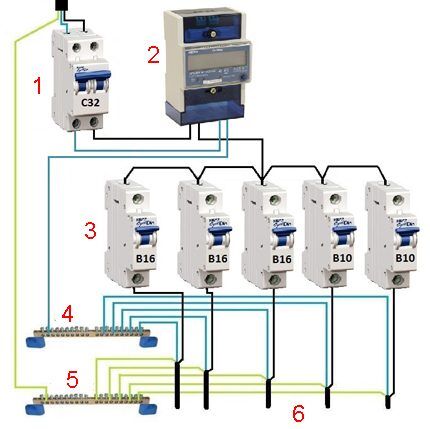
In addition to the distribution function, the installation of an electrical panel provides the functionality of protecting segments of a network section by installing a switchboard cabinet inside the box circuit breakers and other protective devices.
Also, the design scheme may provide for the introduction of control functions - installation of devices that perform:
- current frequency monitoring;
- voltage level control;
- checking for phase presence, etc.
As a rule, the functionality of the electrical panel is determined by the level of complexity of the electrical network, as well as the technological (household) equipment included in the operating area.
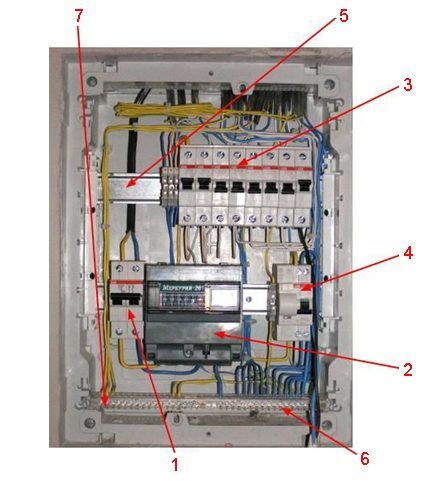
Despite the relatively small dimensions of the structure, which is a characteristic feature of household networks, the installation of a home distribution board is an important process that should be given special attention.
Here, low-quality connections, the use of switching circuits that have not been previously calculated, as well as the refusal to use reliable grounding elements are unacceptable.
Calculations and diagramming
To figure out how to assemble a household electrical panel, you must first draw up a diagram of such a design. In turn, drawing up a diagram is preceded by calculations, with the help of which electrical equipment is selected.
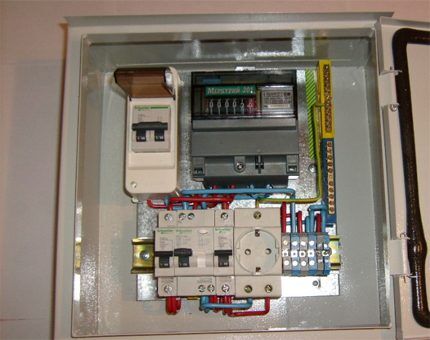
The electrical parts that make up the internal contents of the electrical panel are usually represented by the following set:
- circuit breakers;
- safety blocks;
- contact bars;
- packet switches;
- accessories such as staples, clamps, bushings, etc.
Despite the relatively low requirements for household electrical installations, compared to the industrial version, the principle of energy distribution remains unshakable. That is, each consumption group is built by a separate segment of the general network.
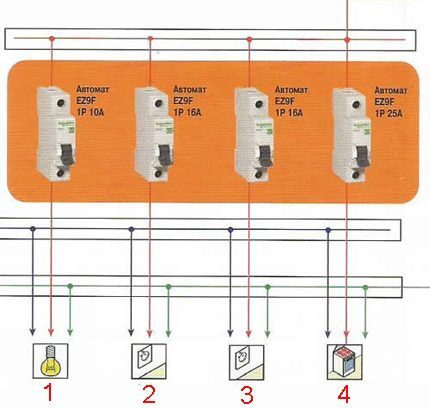
A house or apartment with modern equipment traditionally contains fairly high-power equipment. For example, an electric stove, a microwave oven, a washing machine.
Equipment of this class is connected as a separate group when installed inside a switchboard. Accordingly, this group requires the installation of an individual switching and blocking node.
A total calculation of power consumption is made for such a group, taking into account the safety factor. In other words, the power data for electric machines taken from the passport is summed up.
A safety margin is added to the amount received - approximately 30% of the amount received. As a result, there is a power value according to which electrical equipment is selected for installation of the group unit - a package box, a switching machine, a safety block.
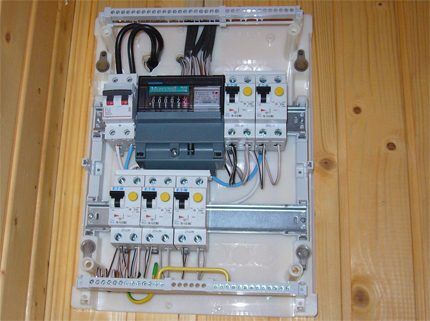
In a similar way, any other group of a separate network segment is created, for example, separately for sockets, for lighting, for a heated floor system, etc.
For standard apartments, creating a large number of groups is not relevant. Here they are usually limited to two, maximum three groups. But for suburban real estate, multi-group schemes are quite commonplace.
Step-by-step installation process
You can do the installation work and assemble the shield yourself. But this will require knowledge and electrical installation skills.
Moreover, connecting the electrical panel to power lines is possible only by a professional electrician who has the appropriate access to carry out this work. Unauthorized connection is dangerous to health and life, and is fraught with big problems, including fines.
But you can prepare the box, purchase the necessary machines and other components on your own. Let's take a closer look at how to do this correctly.
Stage #1 - preparing to install the cabinet
Installation “from scratch” usually involves the presence of a niche in the wall that has already been prepared by the builders and that everything has been placed in the area of this niche. electrical cables and wires, belonging to the apartment (house) scheme.
Such a “landscape” usually looks like a rectangular niche carved into the wall, where first of all you need to select a cabinet of appropriate (suitable) sizes.
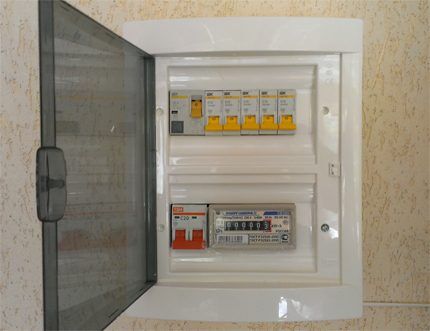
If there is no prepared place, you will have to make a niche with your own hands or use wall-mounted installation.
In the second case, the installation site is marked taking into account the overall dimensions of the electrical panel. In principle, these are standard construction works that do not present any special difficulties.
Cabinets for electrical panels are assembled from durable and strong materials, but relatively light.
As a rule, the following is used to make a box:
- thin-walled (1-1.5 mm) sheet metal;
- metal connecting corners;
- screws and nuts.
In most cases, a ready-made box is purchased, because the range on sale is huge, including plastic products. The classic design shape is a rectangle or square.
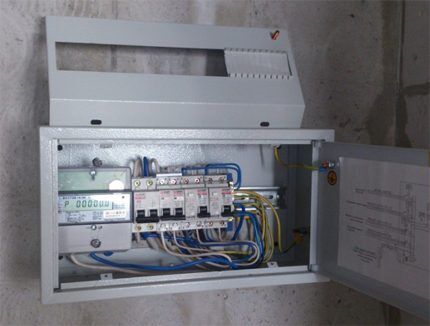
Outdated cabinet designs required installation inside the rear panel based on dielectric materials (hard rubber, textolite, etc.), where electrical equipment was mounted. In principle, such a scheme for everyday life can be used in modern conditions.
Stage #2 - internal filling of the electrical cabinet
Modern architecture is somewhat different.The cabinet is made entirely of metal, and inside, on the back wall, metal cross-beams (DIN rails) are also installed.
All technical equipment is “put on” these traverses:
- machine;
- RCD;
- switch;
- other electrical installation products.
According to modern standards, any of the above elements is designed for installation on a DIN rail. It is also useful to sign all devices installed on the rail, and additionally draw up a diagram with the signatures of all electricity consumers in the apartment/house.
Of course, you can deviate from these rules, given that installation on traverses simply provides ease of installation/removal of equipment. But then you should consider options for reliable fastening.
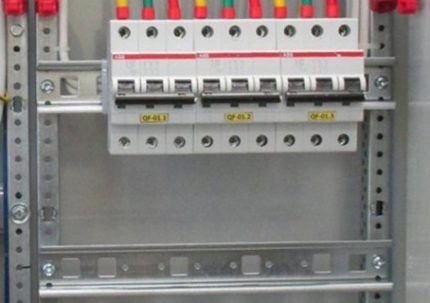
In addition to the DIN rails, one or two insulated plates with screw terminals are mounted inside, usually in the lower part - a busbar for neutral and grounding conductors. Additional buses can be used for contact groups of low-voltage equipment - relays, modems, etc.
It is recommended to make the electrical cabinet drawer as spacious as the size of the niche cut into the wall allows. The equipment should be placed inside rationally, in such a way that it is convenient to maintain and remove in case of replacement.
That is, the assembly of the box, again, must be preceded by a calculation of the required space for installing the assembly components. Any electrical cabinet must be equipped with a door and a lock.
Stage #3 - performing conductor insertion
The supplied power line, as well as conductors and cables taken directly from the apartment (house), must be led inside the assembled cabinet. Accordingly, a sufficient number of holes will be required on the top and bottom sides of the box.
The diameters of the holes must ensure free passage of cables (wires). In this case, each hole must be equipped with a protective insulating ring (rubber, plastic).
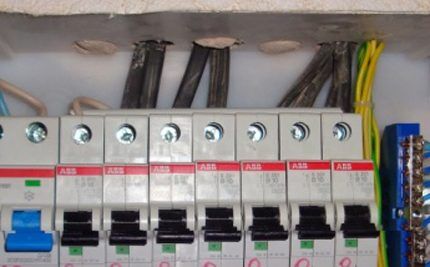
At the cable inlet and outlet, as a rule, clamping clamps are installed, by means of which the conductor is securely fixed to the cabinet wall for internal installation and/or to the base plate (plate) on which the cabinet is fixed for external installation.
Also, a grounding bus interface is made on the side or bottom wall of the structure. A hole is drilled for a bolted connection or a ready-made one is used, if one is provided on the box body. A grounding bus is connected to this connection during the installation process.
Stage #4 - securing the shield to the wall
It is more convenient to perform all the above described actions outside the main installation area. Namely:
- cabinet assembly and preparation;
- installation of traverse tracks (DIN rails);
- placement and fastening of zero tires;
- preparation of passage holes;
- placement of communication equipment;
- installation of door and lock.
Experienced electricians advise mounting a box that has already been prepared, assembled, and even partially completed, in a designated area of the construction niche.
The construction project usually provides for the insertion of anchors to secure the electrical panel.If there are none, you need to prepare a reliable base for fasteners.
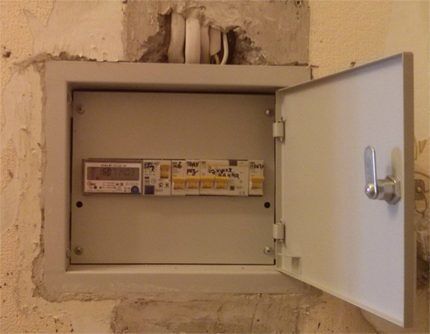
There are many options for making anchor elements. For example, a simple way is to install a pair of fairly powerful metal corners vertically or horizontally, at a distance of the height or width of the cabinet. The electrical cabinet is already attached directly to the corners.
Stage #5 - connecting devices to the power grid
Next, the switchboard is fully equipped with the required electrical equipment, all working cables are brought inside and connected according to the drawn up diagram.
The last thing to do is enter the power line into the electrical panel area and then connect it to the input package switch. From the package switch, the centralized line is connected to the input circuit breaker.
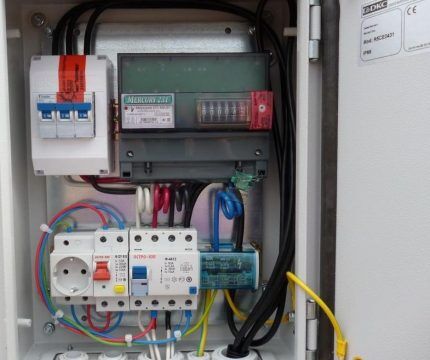
Before applying voltage, all group switches are set to the “off” position. After turning on the batch switch and the input machine, group machines are connected in series, starting from low-power equipment.
Conclusions and useful video on the topic
A video showing the work of assembling an electrical panel “from scratch” is an effective aid to a novice electrician.
It is recommended that you watch the video instruction in order to significantly enrich your personal knowledge base in this way:
It is quite possible to build an electrical panel with your own hands.Another question is whether this makes sense, given the variety of finished products on the market. You can choose a box of any configuration - for a variety of construction projects.
But in order to assemble the panel efficiently and correctly, including the installation of machines, meters, switches and other equipment, you need knowledge and considerable electrical installation experience.
And to enter the supply line and connect consumers to it, you will need a professional electrician with permission to perform this type of work.
If you have the necessary knowledge or have ever assembled an electrical panel yourself, please share valuable advice with our readers. Tell us, perhaps there are some subtleties that we did not mention in this material? Leave your comments in the block below.



